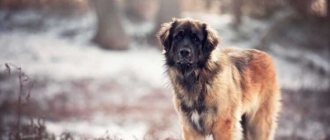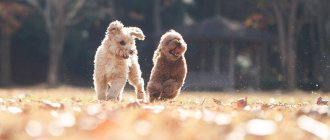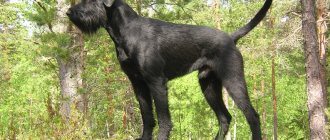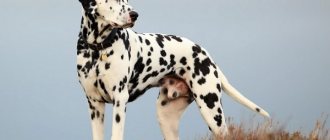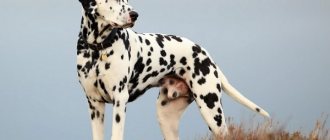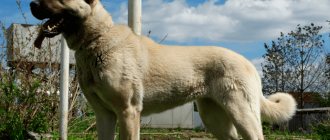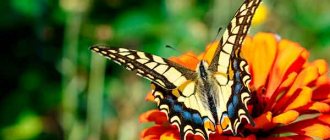The Dalmatian is a dog famous all over the world thanks to the Disney cartoon. This is a devoted and active companion, a true friend for all family members. He has a recognizable bright appearance with a characteristic spotted pattern on his white coat. This is a kind, sociable and cheerful dog. But it also has disadvantages, which can cause problems for inexperienced dog breeders. Therefore, you should not get a Dalmatian without first studying the characteristics of the breed, its pros and cons, and reviews from the owners.
- Head
- Education and training
- Care
Breed traits
Breed traits (on a 5-point scale)
| Dalmatian | |||
| Activity | in the house | 3.8 | |
| on the street | 4.6 | ||
| Obedience | training | 3.1 | |
| strangers | 3.7 | ||
| Domination | in family | 3.1 | |
| over dogs | 3.8 | ||
| Defending your territory | from people | 3.6 | |
| from dogs | 4 | ||
| Sociability | in family | 4.3 | |
| with strangers | 2.7 | ||
| with dogs | 2.6 | ||
| Concentration | in family | 1.8 | |
| in front of strangers | 2.5 | ||
| with dogs | 2.1 | ||
| Aggressiveness | in family | 2.3 | |
| to strangers | 3.2 | ||
| to the dogs | 3.5 | ||
| to cats | 3.3 | ||
| Family behavior | calmness | 3.3 | |
| demand for affection | 4 | ||
| excitability | 4.2 | ||
| playfulness | 4.1 | ||
| excessive barking | 2.8 | ||
| behavioral breakdowns | 2.9 | ||
| Tolerance for children | up to 4 years | 2.9 | |
| over 4 years old | 3.3 | ||
| Institutional use | watchman | 4.2 | |
| bodyguard | 3.2 | ||
This breed is often compared to the following dog breeds: Doberman Pinscher, Labrador Retriever, Great Dane, German Shepherd, Siberian Husky.
The photo shows what a Dalmatian looks like:
Dalmatian
Dalmatian
Adult Dalmatian
Teenager
Interesting facts about the Dalmatian
- The breed has become a mascot for firefighters in the UK and USA.
- This is the only dog breed that is covered in spots.
- In 18th century England, Dalmatians were a symbol of status and position in society.
If you decide to get a dog, then get ready for the following: you will often have to clean up little mistakes after your puppy; investments will be required in annual vaccinations, feeding, toys, ammunition, etc.; any animal requires attention and communication, so if you don’t have time, then there will be no mutual understanding with your Dalmatian puppy. Big changes are coming in your life. If you can handle this, you will find a loyal friend for life. Character of the Dalmatian: who is better to take a bitch or a dog?
Dalmatian The character of a dog depends on heredity and breed characteristics, but proper upbringing and training is also of no small importance. In the article... Read more
Dalmatian color
Dalmatian Color is a canine term that refers to the color of a dog's coat. It is one of the most important traits in breeding... Read more
Training and education of a Dalmatian
Dalmatian Raising a dog is about developing correct behavior. This is the basis for successful training. Training is a set of activities aimed at… Read more
Dalmatian diseases
Dalmatian Each breed of dog has a predisposition to certain diseases. We have collected information about typical diseases of the breed. Remember the symptoms of the disease, the risk... Read more
Dalmatian
General characteristics of the Dalmatian dog breed
These smart, active and cheerful dogs make good companions for active owners. Their memorable appearance attracts attention, and their friendliness and lack of aggression makes it possible for families with children to have such a pet. This is an ancient breed that has been known for several thousand years. But it gained wide popularity in the 60s of the 20th century thanks to the cartoon “101 Dalmatians”. It shows the ideal pet, loyal and intelligent.
The Dalmatian can truly make the best family dog. He loves people, is able to understand their mood and give joy. But for this he needs to be raised correctly. In fact, this dog has a complex independent character. He can be stubborn and requires a lot of attention. Only an experienced dog breeder can raise this dog to be a wonderful companion. And his high intelligence, natural kindness and ability to empathize make him a good rescuer and service dog.
| Options | Characteristic |
| breed name | dalmatian (Dalmatian) |
| country of origin | Croatia |
| year of registration | 1926 |
| group of breeds according to the ICF classification | hounds |
| application | hunting dog, companion |
| life expectancy | 10-13 years |
| height | males 56-62 cm, females 54-60 cm |
| weight | males 27-32 kg, females 24-29 kg |
| character traits | playful, sensitive, cheerful, willful, touchy |
| aggressiveness | non-aggressive, but may be suspicious of strangers |
| attitude towards a person | loyal, need attention, do not tolerate loneliness well |
| intelligence | very smart, easy to train |
| difficulty of care | Sheds a lot, no dog smell |
| activity | very active, energetic, requires physical activity |
What is the correct name of the breed?
The name of the breed comes from the region of Dalmatia on the Balkan Peninsula. But earlier this dog was called Dalmatian dog, brindle dog, Danish hound, harlequin. The modern name did not take hold immediately.
There is still debate as to which is correct: Dalmatian or Dalmatian. The first option is often used. But this can be called a person born in Dalmatia. In relation to the breed, the name Dalmatian would be more correct.
pros
These dogs gained wide popularity not only thanks to the Disney cartoon. This dog really has many positive qualities. If raised correctly, she will be an ideal pet and companion. Dalmatians have the following advantages:
- expressive, attractive appearance;
- good-natured, cheerful character;
- they are sociable and make contact well;
- easy to learn, quick-witted;
- treat children well;
- loyal, affectionate, love people and know how to empathize;
- strong, resilient, can make independent decisions, thanks to which in a dangerous situation they can save the owner’s life;
- live peacefully with other pets;
- balanced, resistant to stress;
- do not show aggression;
- with proper upbringing, it is an easy-going, obedient dog.
Minuses
But the breed is not suitable for everyone. Elderly people, homebodies and those who are away from home for a long time should not have it. This dog is quite large and active, so it is difficult to keep it in a city apartment. She requires constant attention and great physical activity. Those who want to get a Dalmatian need to know its disadvantages:
- noisy, often raises his voice;
- early socialization and strict education are required, otherwise the dog will become uncontrollable;
- you need to walk for a long time, run, without physical activity the dog can destroy the house;
- stubborn, strives to dominate;
- may be vindictive and touchy;
- The fur sheds a lot.
The video will tell you about the pros and cons of these dogs:
Video: Pros and cons of the breed.
Video: Dalmatians: features of the breed.
Video: Dalmatian.
How to choose a Dalmatian puppy
The Dalmatian is a very beautiful, artistic and active dog. It is perfect for an active and sporty person who will devote enough time to education and walks. The dog cannot do without physical activity. If you like outdoor games, hikes and sports, a cheerful Dalmatian will fit perfectly into your life.
Those who are constantly away from home and those who prefer a passive lifestyle should not have a restless pet. This breed is not recommended for elderly people and families with small children; it is not very suitable for an inexperienced dog breeder.
Before getting a large dog, you should evaluate not only your lifestyle, but also your financial capabilities. High-quality food, veterinary services, things for the dog - all this is quite expensive. Consider whether you are ready for such expenses.
Do not buy a Dalmatian puppy until he is at least one and a half months old. Only at this age can it be determined whether he suffers from congenital deafness. Be sure to ask the breeder for test results.
If you are determined to buy a Dalmatian puppy, look for a reliable kennel. Taking a large breed kitten from unknown people is dangerous. He may be physically and mentally unhealthy. Chat on forums of breed lovers, find out independent opinions about breeders. Then it would be nice to go and see with your own eyes where and how the dogs are kept.
When choosing a puppy, pay attention to its appearance; it must be healthy and correspond as much as possible to the standard exterior. Evaluate the character of your future pet. Dalmatians are already extremely curious and active at a young age. Therefore, choose someone who is eager to get to know each other and is not shy.
History of the origin of the breed
Dogs that look like modern Dalmatians have been known since ancient Egypt. Descriptions of spotted dogs are found in documents from different countries and eras. There are many images of such dogs dating back to the 16th century. Usually in the drawings they were chasing prey or sitting next to hunters. The earliest mentions of spotted dogs in history were found in Dalmatia. This region, now part of Croatia, is recognized as the homeland of Dalmatians.
English breeders started talking about the breed officially in the 18th century. Already in documents of that time it was called Dalmatian. The British were breeding these dogs, which were also called Italian. White English terriers, pointers, and Great Danes were used in the selection.
These dogs were usually used to hunt birds and wild boar. Their endurance and sensitive sense of smell allowed them to run long distances and smell prey from afar. Then people noticed these dogs' ability to tirelessly run long distances. They began to be used to escort and guard carriages on long journeys. Because of this, they were also called carriage dogs. For a dog to fit under the carriage, its height must be no more than 60 cm.
When Dalmatians came to the United States, they began to help fight fires. They were used as a siren in front of a fire carriage. Until now, this dog is a symbol of firefighters and is used in rescue and search operations. Dalmatians are hunters, shepherds, and rescuers. Thanks to their artistry, in the Middle Ages they often performed in traveling circuses. And after the release of the cartoon “101 Dalmatians” in the early 60s of the 20th century, they began to be used as companions.
In Great Britain and the USA the breed was recognized at the end of the 19th century. Dalmatians began to participate in exhibitions, and the first breed standard was created. But it was officially recognized by the International Canine Association in 1926. The breed appeared in Russia only in the 80s of the 20th century, but did not immediately become popular.
The video will tell you about the history and characteristics of dogs of this breed:
Video: Interesting facts.
Video: Interesting facts about the breed.
Health
Dalmatians have quite good health. Predisposed to the following diseases:
- deafness is the most common disease
- urolithiasis disease
- cataract
- dysplasia of the elbow and hip joints
- skin diseases
Preventive measures to protect your Dalmatian puppy
- To keep your Dalmatian puppy completely safe, you first need to minimize his contact with unfamiliar dogs, especially strays. Therefore, you should not let your dog off the leash, as in this case it will become impossible to control its behavior and communication with other dogs. Since a dog can easily become infected with distemper from simply touching the nose of a sick animal. This disease can be transmitted to a dog through sniffing. Your dog can become infected with trichophytosis from contact with the lichen-affected fur of a sick dog. Naturally, it is impossible to completely exclude a dog’s communication with other dogs, since it must be socialized. Therefore, try to find friends with dog lovers who look after their animals. By adhering to this rule, you can eliminate the risk of pathogen transmission by 80%.
- You should walk your dog in places where there are no landfills. Since garbage very often attracts rodents, which in turn are very often carriers of various infections. Gray rats are especially dangerous because they carry such a serious disease as leptospirosis.
- You should not allow your dog to sniff other people's feces, as they are a source of worms.
- Monitor your Dalmatian's health. Pay attention to even the most minor changes in his behavior. For example, your dog may appear lethargic, lose his appetite, or have a dry nose. Or you may notice that the dog begins to shed, and this has nothing to do with seasonal shedding. If hair loss becomes excessive, this is the first symptom indicating health problems in your pet. And only you can help him. Therefore, it is important to take the dog to the veterinary clinic in time, where the disease can be overcome for sure. In no case should you ignore the symptoms, since advanced infections are much more difficult to treat, and sometimes even impossible. If you start treating your dog, the disease can lead to his death or he will develop serious complications that will affect his hearing, vision, limbs and much more.
Description of the appearance of a Dalmatian
The Dalmatian is an elegant, strong, large dog. The body is almost square. The ratio of height at withers to length is 9:10. The average height of males is 58-60 cm, females are slightly lower. These are strong, harmoniously built, lean hound dogs. With such growth, the weight of an adult Dalmatian is small - up to 27-30 kg. He moves energetically, freely, and is distinguished by endurance.
A characteristic feature of this dog’s appearance is its coloring. No other breed has such an unusual pattern of dark spots on white fur. Therefore, even non-specialists can easily recognize it.
The first Dalmatian breed standard was developed at the end of the 19th century. It has been revised several times, with the last changes being made in 2010. But the basic requirements for appearance remained the same as when the breed was formed.
Head
The head is elongated, wedge-shaped, rather flat. The muzzle is elongated, gradually tapering towards the nose. The stop is well defined, with a noticeable groove in the middle of the forehead. There are no folds on the head. Lips fit tightly. The jaws are strong, scissor bite, dense. The nose is large, the color depends on the color of the spots: black or brown.
The ears are medium-sized, triangular, wide at the base. Set on wide and high, hanging down and lying close to the cheeks. The eyes are medium-sized, oval, widely spaced. The eyelids are pigmented and fit well. The eye color of the Dalmatian is dark or light brown depending on the color of the coat. The look is smart, attentive.
Torso
The neck is long, muscular, widening towards the shoulders. The physique is harmonious and strong. The chest is deep, the back is straight, the stomach is tucked, the lumbar slope is slight. The tail is long, straight, tapering towards the tip. The dog should not twist it into a ring or throw it over its back. In an excited state, he only rises a little.
Limbs
The limbs are straight, muscular, and set parallel. Elbows pressed to the body. The knees are well defined. All joints are well balanced, thanks to which an adult dog can run for a long time and quickly. The paws are compact, the toes are collected in a ball, arched.
Coat and color
The Dalmatian's coat is hard, short and dense, without undercoat. It should be shiny and smooth. The only Dalmatian color allowed. It is white with black or chocolate spots. Unlike the marbled and speckled colors of other breeds, the Dalmatian has them evenly distributed throughout the body, on the head, ears, tail, and limbs. The spots have clear contours, are usually round in shape and should be the same color.
Each Dalmatian's spotted pattern is unique. There may be more or fewer spots, they can be of any size. The only requirement of the standard is that they must be the same color. There are two varieties of this feature:
- white Dalmatian with chocolate speckles, he has lighter pigmentation of the eyes and nose;
- A Dalmatian with black spots also has dark eyes and nose.
Any other stain color is not allowed. It is also a disqualifying defect if they are fused, very small or large, have an uneven shape and unclear color. Another characteristic feature of Dalmatians is that their spots do not appear immediately. Puppies are born white, the pattern begins to form in the first month. New spots may appear up to one and a half years of age.
Photos complement the description of the appearance:
With chocolate stains
Dalmatian with chocolate spots
Dalmatian with black spots
With black spots
With chocolate specks
Possible diseases
These dogs are more prone to genetic diseases than any other. But there are also acquired ailments, among which the leading ones are problems with the kidneys, skin and heart. The scourge of the Dalmatian breed is urolithiasis.
As in humans, the urine of these animals produces uric acid, not urea. Signs by which one can determine that the disease has struck the dog are lumbar pain, due to which the animal does not allow petting or touching this part of the body.
The dog stops jumping and standing up using its hind limbs. It's hard for him to settle down. The attacks come in periods, last for a couple of days, and after a while they repeat again. Soon the condition worsens.
Dalmatian puppies are born white without spots
If the disease is neglected, it can lead to dire consequences. As a preventive measure, drinking regimen and physical activity, including long walks, are very important. Another vulnerable spot is the skin. These include dermatitis, allergic reactions, and even baldness.
In case of any suspicious reactions, do not neglect the services of a veterinarian. Timely diagnosis will help avoid serious complications. The lifespan of Dalmatians depends on care, nutrition and the degree of stress. In a good situation, the dog will delight its owners for up to 13-14 years.
Dalmatian character
Despite their reputation as the ideal family dog, Dalmatians have complex personalities. They are not suitable for inactive and quiet owners and will not become a “couch” pet. This is a very active, energetic animal. Needs regular physical activity and likes to run a lot. If you don't let your Dalmatian express his energy outside, he will exhibit destructive behavior at home. Therefore, this breed is best suited for athletes and outdoor enthusiasts.
This dog has a balanced character and high intelligence. But she shows obedience and calm behavior only with proper upbringing. Such a pet is able to adapt to the owner, senses his mood and tries to do everything he asks. Dalmatians are kind, not aggressive, do not get into fights and are calm with strangers. But if the owner is in danger, they boldly rush to defense. Caution is not characteristic of this dog.
The following character traits can be noted:
- friendliness;
- persistence;
- equilibrium;
- curiosity;
- sociability;
- non-conflict;
- resourcefulness;
- artistry;
- independence;
- waywardness;
- cheerfulness.
These dogs love children and tolerate their mischief. Their character is childish - just as playful, active and restless. This kind dog will never knowingly harm a child. Although it is not recommended to leave them alone with children. This is a rather large, active dog, sometimes even violent, he can accidentally push a child. But for school-age children, Dalmatians become best friends and loyal protectors.
The Dalmatian does not single out one owner and treats all family members equally. This dog requires constant attention and loves to participate in all human affairs. Therefore, it is difficult to endure loneliness, he will be bored and may chew on things. Gets along well with other pets, even cats. Many owners call it a "dog holiday." After all, this is a bright, artistic, cheerful and energetic pet that can cheer you up.
Education and training
Due to their natural hunting instincts and freedom-loving nature, these dogs require strict training and timely socialization. Dalmatians are stubborn, independent and restless. Therefore, sometimes they are said about them that they are stupid and cannot be trained. But in reality, you just need to find the right approach to the dog, interest it and gain authority.
You need to start training your puppy from the first days of his arrival in the house. The baby must immediately understand how to behave. Prohibitions must be observed by all family members; the dog should not be given any concessions. Aggression or physical punishment is not acceptable. These dogs are often touchy and vindictive. For incorrect behavior, you can scold in a stern voice and be deprived of play or communication for a while.
Dalmatians are smart, they quickly understand what is required of them. This dog is smart and easy to train. By six months, with proper training, she should understand more than 10 commands. When upbringing, you need to maintain consistency and firmness. Training should be regular and interesting for your pet. You need to use rewards in the form of affection or treats.
Dalmatians are artistic and easy to teach tricks. They can perform flips, bows, and you can practice agility and freestyle with them. This dog loves attention and tries to make his beloved owner smile.
Raising and training a Dalmatian
A properly raised Dalmatian is calm and balanced. He understands his owner very well, gets along well with all family members and behaves appropriately during walks. To achieve this result, you need to train your puppy from a very early age. Moreover, one must first treat him as an unintelligent child, and then as an obstinate teenager.
First, your pet must learn his name and understand what is not allowed and what actions are approved. We need to discuss it with the whole family and develop our own system of prohibitions and permissions. Everyone must follow it at all times. For example, if you decide that the dog shouldn't sleep on the couch, don't let the puppy do it, even if he whines and you feel sorry for him. Unless you want to raise a beggar, don't allow your dog to sit at the table during meals.
Then you need to patiently teach the dog the basic commands: “come to me,” “next to me,” “sit,” “lie down.” It is especially important to teach her not to pull on the leash, but to move at the person’s leg. Without this skill, walking will turn not into pleasure, but into pain. A young Dalmatian will benefit from a general training course. Moreover, group classes are the best option. These dogs love company and easily imitate others. In addition, by communicating with other people's animals and people, the puppy will learn the rules of behavior in society. He will be more tolerant and friendly towards others.
Dogs of this breed do not tolerate rough treatment; they can become angry and uncontrollable. At the same time, young Dalmatians strive to take a leadership position. Attempts to dominate must be stopped immediately, but calmly and without violence.
Dalmatians are naturally very curious, they are extremely interested in everything new and unknown. Moreover, they accept changes easily and painlessly. The owner needs to use these qualities. It’s worth walking your dog in new places, taking it with you out of town, on trips, and introducing it to people. Thanks to the abundance of impressions, the Dalmatian will loyally perceive any environment. He won't cause any unnecessary trouble.
Dalmatian dogs have a very flexible character and are easily adaptable. Therefore, they can be adapted to a wide variety of activities. They can become hunters, bloodhounds, nannies, rescuers, security guards, athletes, artists, or just couch potatoes and bosom friends. What exactly the Dalmatian will be is up to the owner to decide.
Sometimes Dalmatians, like other young dogs, can be stubborn and capricious. But you should not give your pet to a dog trainer for behavior correction. Representatives of this breed become strongly attached to their owner and family. Therefore, someone close to you should train the dog. It is better to take a general training course with your dog. Such activities will further strengthen the bond between a person and his pet.
Features of keeping Dalmatians
The Dalmatian is a fairly large and active dog. It is best to keep her in a private house, where there is room to run around on the property. But the pet must live in the house. Due to the short coat and lack of undercoat, this dog does not tolerate cold well. In winter, it is even recommended to wear warm clothes for her. This dog cannot be chained or kept in an enclosure. Psychological trauma can develop from loneliness.
Regardless of how it is kept, the Dalmatian needs long, active walks. It’s better if it’s jogging or playing on the dog park. This dog will happily accompany its owner on a hike, bike ride, or jog. Having splashed out his energy on the street, he will behave calmer at home. And so that the pet does not get bored, you need to buy him more different toys that he will chew in the absence of the owner.
Care
The coat is easy to care for, it is short, does not mat and does not smell like a dog. It sheds throughout the year, especially heavily in autumn and spring. It is recommended to brush your pet 2-3 times a week with a special brush or rubber mitt.
You shouldn't bathe your Dalmatian often, although the white coat gets dirty quickly. You can wipe it with a damp towel after a walk. Be sure to wash your paws well, especially in winter, as irritation may develop due to reagents on the road. For washing, you need to choose special hypoallergenic shampoos; these dogs often exhibit allergies and dermatitis. You need to regularly monitor the condition of your dog’s ears and eyes, trim his nails, and brush his teeth.
What is the best way to feed a Dalmatian?
It is important to feed your pet properly. Not only health, but also mood and skin condition depend on nutrition. It is better to choose balanced dry food, but you can also use natural food. You just shouldn’t overfeed your dog; if there is a lack of physical activity, in this case it will quickly gain weight. Moreover, Dalmatians have a good appetite and eat quickly.
Therefore, it is better to find out from the veterinarian how much food this dog needs. Typically, no more than 3-6 glasses per day are recommended, depending on weight. It is easy to dose the amount of dry food; the packaging indicates how many grams should be given. A puppy is fed 4-6 times a day; for an adult dog, 2 feedings are enough.
If you feed your pet natural food, at least half of the diet should be lean meat. Better turkey or rabbit. Sea fish, cereals, vegetables, and cottage cheese are also allowed. With natural feeding, additional vitamin and mineral supplements must be given. It is advisable to exclude semolina, millet and corn porridge, legumes, baked goods, sweets, fatty and spicy foods. Due to a possible allergic reaction, it is better not to feed eggs, soy, dairy products, or sausages.
Many owners choose ready-made food. It is better to buy super-premium or holistic options. Veterinarians do not recommend types intended for active dogs. It is better to choose dry food for your Dalmatian with a protein content of no more than 22%, as these dogs are prone to urolithiasis. Suitable brands include Hills, Acana, Royal Canin, Golden Eagle Holistic, Go! Natural, Wolfsblut.
Health and illness
On average, Dalmatians live 10-13 years. Their health is quite good. But there are several diseases characteristic of the breed. The most common is deafness. This problem occurs in approximately 8-12% of dogs of this breed. This is due to the gene that provides the unusual color of the Dalmatian.
These dogs are also prone to urolithiasis, hip dysplasia, and allergies. They have atopic dermatitis, inflammatory eye diseases, and pathologies of the cardiovascular system. Many diseases are hereditary, and you can avoid the risk of developing them if you buy a dog from a good kennel.
It is important to regularly treat your pet for internal and external parasites, as well as keep all vaccinations. With proper care, a balanced diet and regular visits to the veterinarian, a dog can live 15-16 years.
The video will tell you about the characteristics and maintenance of these dogs:
Video: Reliable guard and devoted companion.
Video: Breed features, care
Nutrition
A feature of the breed is the production of uric acid in quantities that are greater than the permissible values. Acid is produced when a large number of proteins enter the body.
We are talking specifically about satiety with vegetable protein, which is found in vegetables and cereals. This does not mean that Dalmatian dog should eat exclusively animal proteins such as meat and fish.
But porridge in the diet should be limited. You will have to completely exclude corn and semolina porridge from the menu, and significantly reduce the amount of millet, pearl barley and wheat groats, as well as oatmeal. Thus, the only allowed cereals are egg, buckwheat, and rice.
You should be careful about eggs, honey and industrial dairy products in your dog's diet. In addition, it is recommended to exclude soy, sausage and fish and meat, which are processed using liquid smoke.
If a dog is found to have an allergy, the menu is drawn up together with the veterinarian. Another way out of the situation is to select dry hypoallergenic food from the premium segment. The food must be appropriate for age and weight.
Don't go overboard with the quantity. The Dalmatian is a dog with an excellent appetite. Therefore, having quickly destroyed the contents of the plate, he may begin to beg for more or take bites. These actions should be nipped in the bud.
By the way, when choosing between a natural type of feeding or dry food, dog owners, and not only Dalmatians, should keep in mind that, according to dog experts, natural food is preferable and more natural.
But if we take into account that the research was carried out a long time ago, and dry food is being improved from year to year, then at present we can consider dry food to be almost equivalent to products from the store.
And in terms of parameters such as the content of the required proportions of vitamins and microelements, it is even superior to natural food. After all, if a dog eats cereals, vegetables and meat, it is additionally required to include vitamins in its diet.
As for the number of feedings, there are no special subtleties. Adults feed twice a day. Dalmatian puppies eat up to six times a day, and gradually the number of feedings decreases.
Dalmatian puppy
At the same time, for young dogs, meat should make up 50% of the total diet. It needs to be processed - either doused with boiling water or boiled. It is placed in a bowl already crumbled.

